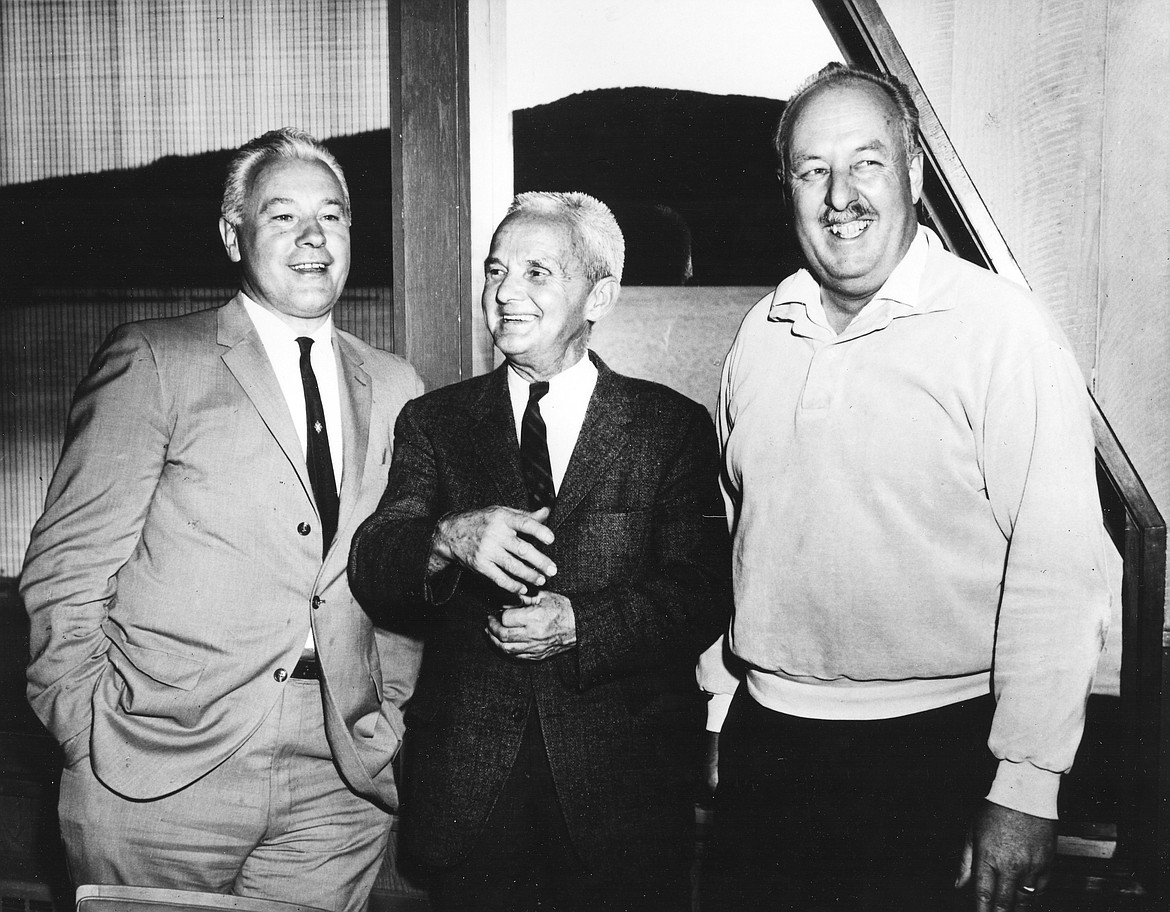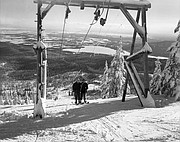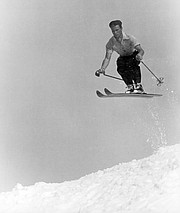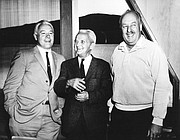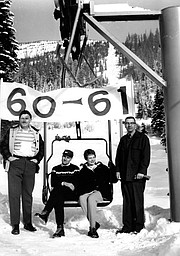75 years on Big Mountain: Decades of memories made at the resort that helped shape Whitefish
Opening day in 1947 drew out an enthusiastic group sporting doubled-up sweaters and long skis — a lift ticket for the brand new T-bar was $2, a burger was 25 cents and a beer cost a few nickels. About 6,900 skiers enjoyed The Big Mountain that year, according to the historical book “Hellroaring: 50 Years on The Big Mountain”.
“Opening day, everybody was pretty excited about it. Ride up, ski down, and do it all over again,” old-time Big Mountain skier Lyle Rutherford said in the book.
In 75 years, Whitefish’s local ski resort has seen a bit of change. From a single T-Bar lift operating on gasolene to give skiers about 1,000 vertical feet, to now 11 chairlifts, plus a magic carpet and a T-bar, that access over 3,000 skiable acres and serve about 460,000 people visiting on average per winter season.
But in a sense, it’s the same — ride up, ski down and do it all over again. The passionate ski culture that formed in Whitefish even before the resort opened, still exists in the roots of the town, the resort and the people here today.
Through the years, the resort has expanded its terrain, added high-speed lifts, built new lodges and adjusted with the times. The changes are many, as any would say who skied the mountain in the early years, but the culture and passion behind skiing remain.
Walking through the Base Lodge, there are numerous old photos hanging throughout. Across the mountain ski runs are named after influential people that helped shape the resort — people like Lloyd ‘Mully’ Muldown, Toni Matt, Ed Schenck and so many more. And, decisions to invest in a new lift or open more terrain are always done with careful consideration to make sure it’s in line with the culture the original founders set out to create all those many years ago, according to WMR President Nick Polumbus.
“[The resort] honors what started with George Prentice and Ed Schenck and Mully Muldown, those guys and what they started... they put the skiing first, it was a passion,” Polumbus said. “...We feel like we’re, even here today in 2022, contributing to a mindset that was started 75 years ago.”
This winter season, Whitefish Mountain Resort has its founders and all those along the way that kept it running to thank as it celebrates its 75th Anniversary season on the Big Mountain.
THE HISTORY
Seventy-five years is a lot of history to recount, so here are some of the highlights.
The Big Mountain opened in 1947 and even prior to that the ski culture began to take hold in Whitefish with the core group of skiers who climbed the Big Mountain to enjoy the free feeling of sliding at high velocities on snow. The members of the original Hell Roaring Ski Club in the late-1930s paved the way and showed all the fun Big Mountain had to offer.
In 1935, the first cabin was built and named Hell Roaring Ski Camp. The group built another cabin, cleared runs and installed a rope tow all by 1939.
After World War II ended, folks from the 10th Mountain Division, a light infantry division of the U.S. Army specifically trained for mountain warfare, were returning and many looking to work in the ski industry. The Whitefish Chamber was eager to form a local ski hill and hoped the Great Northern Railway would partner with them to make it happen on Big Mountain. The railroad surveyors were not impressed, calling the terrain on the mountain “Godforsaken bush country.”
Two entrepreneurs from Great Falls specifically were searching for the right area to open a ski resort in northwest Montana in 1946 after returning from the war. Ed Schenck and George Prentice came up to Whitefish and were met with an eager community that had an interest in a local ski resort as well.
Prentice and Schenck brought in their own investment of $20,000, and the chamber raised $40,000 for the mountain. Winter Sports, Inc. began on March 31, 1947, after $70,000 of stock went for sale at $100 and $200 a share.
It took a long while before investors saw any return though. The mountain struggled in the early years. Despite a lack of facilities and terrain, WSI was selected to host the 1949 National Downhill, Slalom and Combined Championship Ski Races. The resort brought on famed Austrian skier Toni Matt to help design courses and his presence gave Big Mountain a lot of cred in the ski industry.
A massive turning point in the resort’s history was in 1960 when the board decided to build Chair 1, a double chair that would stretch all the way to the summit of The Big. This tripled, maybe even quadrupled the amount of terrain available to ski at the resort.
For the first time, skiers could ride a modern chair lift 2,000 feet to the summit and ski seven days a week. With the new electric-powered, 117-chair lift, the resort could now accommodate up to 1,000 skiers per day.
“That’s probably the most pivotal change in the history of the mountain, in my opinion, just because if you look at where they were skiing before that and then when they were skiing after that, the mountain grew four or five times in skiable acres and doubled in vertical,” said Tim Hinderman, Executive Director of the Flathead Valley Ski Education Foundation and the Ski Heritage Center Museum, in a previous Pilot article.
Throughout the 60s, the lodge was rebuilt after a fire, the resort began night skiing and the Bierstube building was constructed.
A new generation of free-heel and tele-skiers took to the mountain in the 1970-71 season. WSI continued to expand the mountain and added new lifts, replacing the PomaLift with Chair 3 and installing Chair 4. The next season saw about 218,000 total visits, and gross revenues had increased from $11,200 in the first season to $1.1 million. By 1976, stockholders saw the first returns on their initial investments.
In 1985, the Summit House was constructed and the resort finally expanded to the backside by adding Chair 7. Chair 1 was replaced with a high-speed detachable quad in ‘89 and by 1997 Chair 7 was also replaced with a high-speed lift.
“We spoiled everyone in ‘89 when we put in the first detachable chair,” recalls Whitefish Mountain Resort Plant Manager Bob Yeager, who first came to work at the resort as a lift operator in 1987. In his 35-year tenure, he’s seen plenty of projects come to fruition.
The 2000s saw the Telemark World Championships come to The Big Mountain as well as the U.S. Alpine Championships. Huge change came in 2007 when the owners voted to change the name to Whitefish Mountain Resort while simultaneously opening the Base Lodge and upgrading Chair 1 and 2. According to the resort, the name was chosen to associate the resort with the town and community of Whitefish and for less confusion with Big Sky Resort.
The year 2009 was one of the biggest years of improvements in Polumbus’ eyes as that is when the resort began summer activities, opening the Alpine Slide and four ziplines. Beginning operations in the summer helped the resort financially and opened up more opportunity to pursue upgrades and improvements.
“It was a game changer for us, it was like a paradigm shift,” Polumbus said. “And that’s what really kicked off our financial success, but we stayed true to reinvesting.”
Over the last 13 years, Whitefish Mountain Resort has packed in several improvements. The resort added the Flower Point Lift, adding 200 acres of terrain to the north side, remodeled the Summit House, relocated Chair 5 to the East Rim and relocated the Hellroaring chair lift to improve access in Hellroaring Basin.
Yeager says so many people have poured their souls into the resort and it’s where it is today because of the people who kept it going. As someone who maintains all the buildings on the mountain, he has a true appreciation for what went into each project over the years.
“People just go walk into the Summit House like you’re walking into Costco and it’s like wait a minute, that’s a building at 7,000 feet. Do you ever think where the water comes from when you turn on the faucet in the bathroom, or how we get your hamburger up there?” Yeager said, amused. “People don’t think about things like that. That building is so remote... It’s really a complex operation up there.”
These projects through the years are just to name a few, the list of improvements is long in the resort’s 75 years of operation.
THE MEMORIES
Though the history of The Big Mountain, now Whitefish Mountain Resort, is written in several articles, books and recounts filed away in museums, the tale lives on best through the people.
The people who grew up on the mountain, those that came to work at the resort for winter and stayed a lifetime, and of course the founders whose next generations live on to tell the stories. Many have memories of Big Mountain, whether those memories are from 1947, the year the resort opened, or from last season when visiting for the first time. A ski resort brings people from many different walks of life together, all making memories that are sure to last.
Tim Hinderman, who is the son of Karl Hinderman an early Big Mountain skier who ran the ski school for decades, is the keeper of much of The Big’s history as he runs the Ski Heritage Center Museum in Whitefish. Through his work at the museum, he’s been able to talk with many people who share an appreciation for the history of skiing in Whitefish. The ski museum displays photos and information about the early days of The Big Mountain, but he says the most interesting stories lie within the people.
“I think maybe that’s the bottom line is just the stories – because without stories there aren’t people and it’s really people that make it all happen,” he said. “I think the stories kind of convey the history from the people’s perspective.”
Many people near and far have stories to tell of Big Mountain. Yeager remembers years of projects, joking with co-workers and working alongside his brother Doug. Back in the day, he says things ran a little looser than they do now.
“Several of our departments up here, we had our own pop machines that we converted to beer machines. We obviously don’t have those now, but it was the cheapest beer on the mountain,” Yeager joked.
Polumbus says his best memories from the resort thus far are from watching his kids grow up on the mountain, not only skiing but each of them has worked at least a season at WMR.
“What I think is the coolest thing is they’ve all worked here. I think that’s the thing I’m most proud of,” he said. “Watch them go from literally learning how to ski to being employees and contributing to this place that has taken so much of my time and energy. It’s pretty special to see.”
Hinderman remembers the best times on the mountain in junior high through high school skiing with his friends and ski racing.
The Pilot recently asked readers to submit some memories as well.
Dale Dufour, who now lives in Lolo, Montana, said “When I was with the ski patrol back in the mid to late 1960s, we used to shut the lifts down at noon on weekdays so everyone could go eat lunch… Crowds were pretty small and on weekdays most of the guests were staying either in the Chalet or the Lodge and meal plans were part of their package. Don't think that would work today!”
Frank Dailey graduated from Whitefish High School in 1980 and began working at the fine dining restaurant at the lodge on the mountain. He said it was one of the best winters he’s ever had and recalls enjoying meeting a lot of new people.
“I remember the staff would walk up the slope at night after we closed and slide down with bus tubs and serving trays,” he wrote. “...We also partied way too much at the Bierstube.
Pete Sabin says he and his wife first visited Big Mountain in the 90s, they regularly visited until they retired to Whitefish and are now annual pass holders. He says his best memories were watching telemark racing, mainly due to his son who still races.
Whitefish local Kitty Dowaliby says she has 56 years of memories on Big Mountain. Some include trying to grab the big green tow rope, going to church in ski clothes and riding the T-Bar with her dad as it lifted her off the ground.
“Enduring the laughter of the man who ran the PomaLIft as he got a kick out of my red ski hat covered in pom poms… I still have it,” she said.
There’s much more to say about the ski resort that has been a staple in the town of Whitefish for 75 years, but only so much space. The resort has fostered a love of skiing in the town of Whitefish for generations, and will hopefully continue to do so.
“It’s kind of like there’s been a generational love of The Big Mountain just through all the years,” Yeager said. “The families that still return here now with their kids and grandkids. That’s the way The Big Mountain has always felt in this community, to me, it’s like everyone had a certain amount of pride of being attached in some way to Big Mountain.”
While the resort will continue to change in the future, the owners, board and staff have proven they’re committed to finding a way forward while honoring the past.




